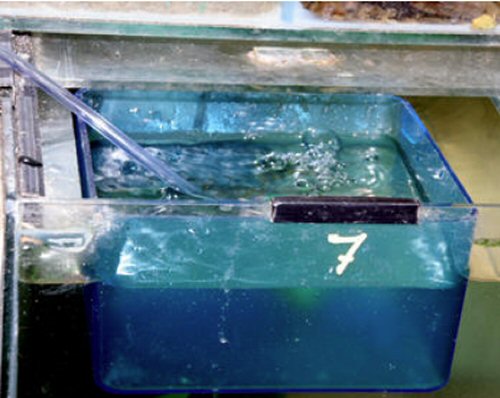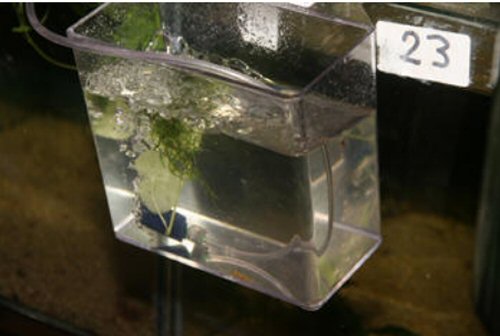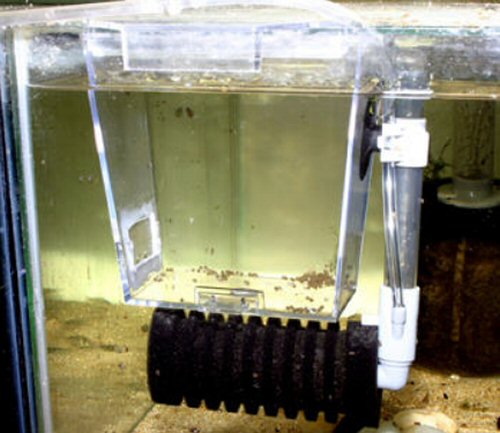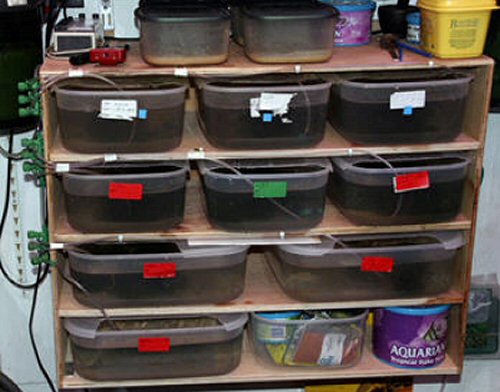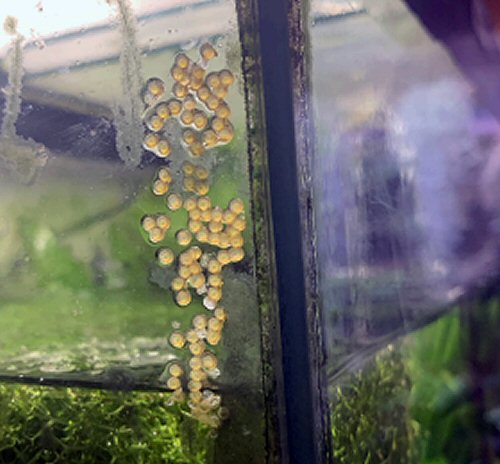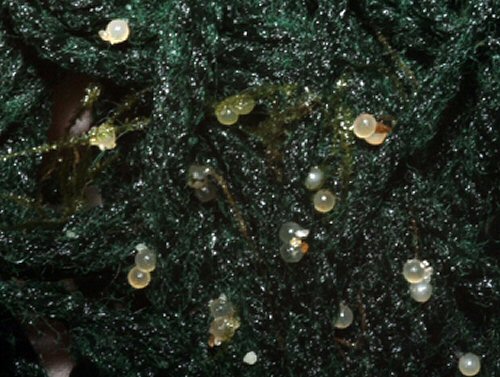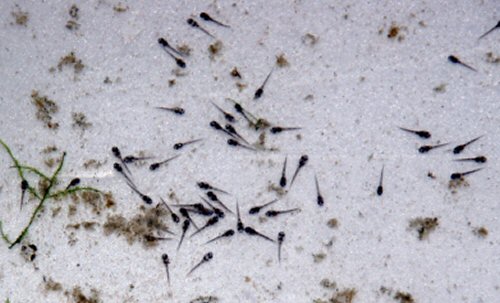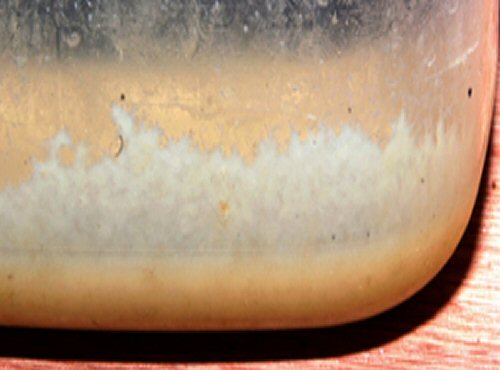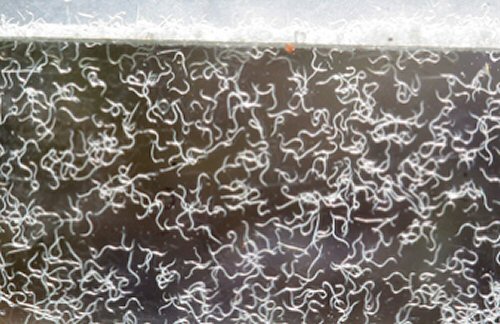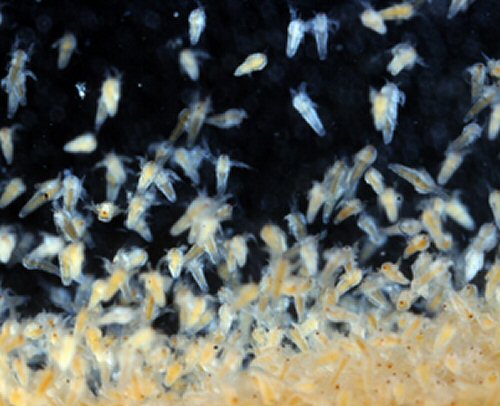SCOTCAT.COM
your internet guide to all things catfish
| Hatching Corydoras & Fry raising |
| by Ian Fuller |
The Floating Container
Floating Container: This is the easiest method of hatching eggs away from the parent fish and once the fry hatch and become free swimming they should be moved to a larger stage one growing on tank or container.
Outside Hanging Container
Outside Hanging Container: This container can either be a hang on the outside of the tank type as shown, or one that floats on the surface of the spawning tank. An air stone is added to create water movement and maximise oxygen absorption.
Internal Hatching Nursery
Internal Hatching Nursery: The internal nursery is the same type of container as shown above but has been modified to take the poly filter on one side and a fine meshed covered outlet 6 mm above the base line on the opposite side. This has a big advantage over the external container in that although it keeps the eggs and fry in a fairly confined space, they are actually still in the same water in which the spawning took place. As the picture shows the small poly filter that is attached to the nursery not only filters the water going into the container, but it also creates a constant flow over the eggs, preventing any particles of debris from settling on them and causing contamination.
Egg Hatching Unit
Egg Hatching Unit: This was the hatching unit I used until recently (2019), prior to scaling back my facility. The smaller containers hold 3 litres and the larger ones hold 4.5 litres. Each container has its own air supply and a close-fitting lid with just a narrow gap at the front to cut down on evaporation. Egg treatment and hatching: Corydoras eggs are sticky and depending on the species the stickiness will vary from just a light tackiness, which is sufficient to hold the egg in place where the female had decided to deposit it, and usually in the aquarium these will be placed all over tank, on plant leafs, on solid objects and the aquarium glass. At the other end of the sticky scale a few species produce very sticky eggs, these species usually deposit their egg close together in a tight clump, sometimes even on top of each other. When we look into the natural conditions these fish live in we usually discover that they inhabit fast moving rivers and streams and the extra stickiness ensures that the eggs remain where they have been deposited until the fry are ready to emerge.
A batch of very sticky Scleromystax. sp. CW147 eggs
Corydoras
habrosus eggs deposited in a polyester spawning
mop. The eggs of the majority of species are not overly sticky and can easily be removed from where they have been laid, by gently rolling them off the object with a finger. Eggs that have laid on the aquarium glass can be removed with the aid of a razor blade; this is the usual method for the very sticky eggs. The process I use for hatching eggs is to put the harvested eggs into a small 3 litre hatching tub containing water from the spawning tank that has a depth of 35mm – 45mm, an air stone is added and one or two Alder cones. The Alder cones release tannins which over a few hours will coat the eggs protecting them from fungal attack. For species that come from clear waters and are not naturally subjected tannins, I will treat the eggs in the container with 5 or 6 drops of Methylene blue, after 10 or 15 minutes the eggs are rinsed through a fine net and the Methylene blue water is discarded this is replaced in the container again with water from the spawning tank. In the cases where Alder cones have been used, theses are removed after 24 hours and again the water in the container is replaces with spawning tank water. Fry feeding
and raising.
Corydoras sp. C139 at three days
After three or four day on Walter worm I will start to add the larger Micro worm and a little pre-soaked crushed tablet food. This is prepared by powdering down a Corydoras tablet and adding a little water making it into a paste, then when it is fed to the fry it forms a very fine cloud, which they can graze on I usually feed the crushed tablet paste in the morning and live micro worm in the evening. As the fry develop and grow larger particle foods are given, I start to add the larger size Grindal worm and newly hatched artemia to their diet, and will add crushed tablet or flake, both pre soaked so that it sinks easily.
Walter Worm
Micro Worm
Freshly hatched Artemia
At around four to five weeks fry are usually showing fully formed fins and looking like tiny versions of the adults and will be constantly searching for food. At this time if available I will add sifted Daphnia and or finely grated frozen blood worm or tubifex. I will also feed frozen Cyclops but no longer use it live, as I have found some Cyclops forms are parasitic and although generally not a danger to Cory fry they carry a sting which can irritate the fry and tends to stop them feeding. This article was first pulished in CorydorasWorld 2020.
|
| Photo Credits |
Author |
If you would like to contribute an article, please e-mail me. You will of course be credited for your work.
If you would like to donate any denomination of money to the site just click the above link button. All proceeds will go to running the site and hopefully to keep it going for a few years yet.
Print or e-mail this factsheet below
